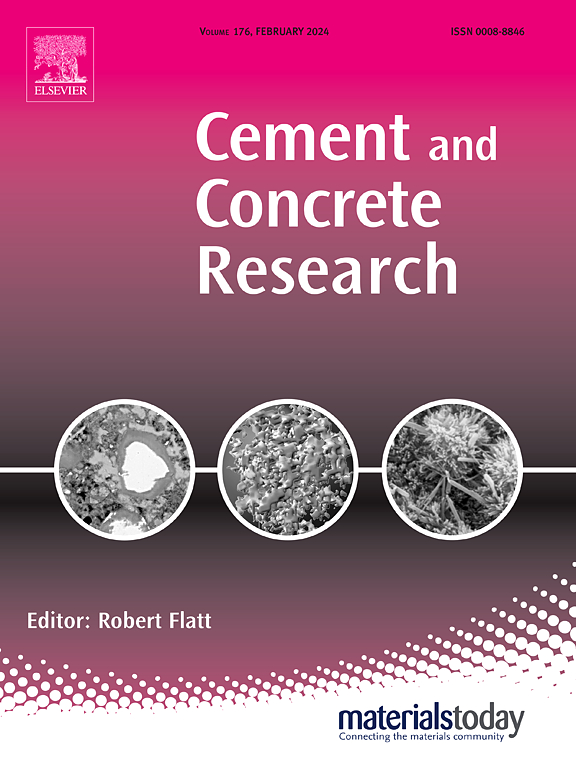Citric, tartaric, and succinic acid effects on C3S dissolution and the nucleation kinetics of CSH and portlandite
IF 13.1
1区 工程技术
Q1 CONSTRUCTION & BUILDING TECHNOLOGY
引用次数: 0
Abstract
Functional additives like hydroxy-carboxylic acids modify the hydration mechanism of Portland cement and are commonly used as set retarders. These retarders can affect the clinker phase dissolution and the crystallization of hydrate phases. However, their specific effects are not fully understood. This study focuses on understanding the role of citric, tartaric, and succinic acid in the dissolution of tricalcium silicate (C3S) and the crystallization of C![]() S
S![]() H and portlandite during the early hydration of C3S. At high undersaturation, we observe that the acids accelerate C3S dissolution, while their sodium salts exhibit minimal effects. At low undersaturation, citrate reduces the dissolution rate by 50 %, and tartrate can fully suppress dissolution in a model experiment with a water-to-solid ratio of 10 000. The suppression appears to be linked to the precipitation of calcium citrate or calcium tartrate. Potentiometric titration studies indicate that tartrate and citrate inhibit the nucleation and crystal growth of C
H and portlandite during the early hydration of C3S. At high undersaturation, we observe that the acids accelerate C3S dissolution, while their sodium salts exhibit minimal effects. At low undersaturation, citrate reduces the dissolution rate by 50 %, and tartrate can fully suppress dissolution in a model experiment with a water-to-solid ratio of 10 000. The suppression appears to be linked to the precipitation of calcium citrate or calcium tartrate. Potentiometric titration studies indicate that tartrate and citrate inhibit the nucleation and crystal growth of C![]() S
S![]() H and portlandite. In summary, we find significant inhibiting effects of citrate and tartrate for the dissolution of C3S and the nucleation of both calcium hydroxide and calcium silicate hydrate.
H and portlandite. In summary, we find significant inhibiting effects of citrate and tartrate for the dissolution of C3S and the nucleation of both calcium hydroxide and calcium silicate hydrate.
柠檬酸、酒石酸和琥珀酸对C3S溶解及CSH和波特兰铁矿成核动力学的影响
羟基羧酸等功能助剂可以改变硅酸盐水泥的水化机理,是常用的缓凝剂。这些缓凝剂会影响熟料相的溶解和水合物相的结晶。然而,它们的具体影响尚未完全了解。本研究的重点是了解柠檬酸、酒石酸和琥珀酸在硅酸三钙(C3S)早期水化过程中溶解以及CSH和波特兰石结晶的作用。在高欠饱和度下,我们观察到酸加速C3S的溶解,而它们的钠盐表现出最小的影响。在低欠饱和度下,柠檬酸盐可使溶解速率降低50%,在水固比为10000的模型实验中,酒石酸盐可完全抑制溶解。这种抑制似乎与柠檬酸钙或酒石酸钙的沉淀有关。电位滴定研究表明酒石酸盐和柠檬酸盐抑制CSH和portlandite的成核和晶体生长。综上所述,我们发现柠檬酸盐和酒石酸盐对C3S的溶解和氢氧化钙和水合硅酸钙的成核都有显著的抑制作用。
本文章由计算机程序翻译,如有差异,请以英文原文为准。
求助全文
约1分钟内获得全文
求助全文
来源期刊

Cement and Concrete Research
工程技术-材料科学:综合
CiteScore
20.90
自引率
12.30%
发文量
318
审稿时长
53 days
期刊介绍:
Cement and Concrete Research is dedicated to publishing top-notch research on the materials science and engineering of cement, cement composites, mortars, concrete, and related materials incorporating cement or other mineral binders. The journal prioritizes reporting significant findings in research on the properties and performance of cementitious materials. It also covers novel experimental techniques, the latest analytical and modeling methods, examination and diagnosis of actual cement and concrete structures, and the exploration of potential improvements in materials.
 求助内容:
求助内容: 应助结果提醒方式:
应助结果提醒方式:


